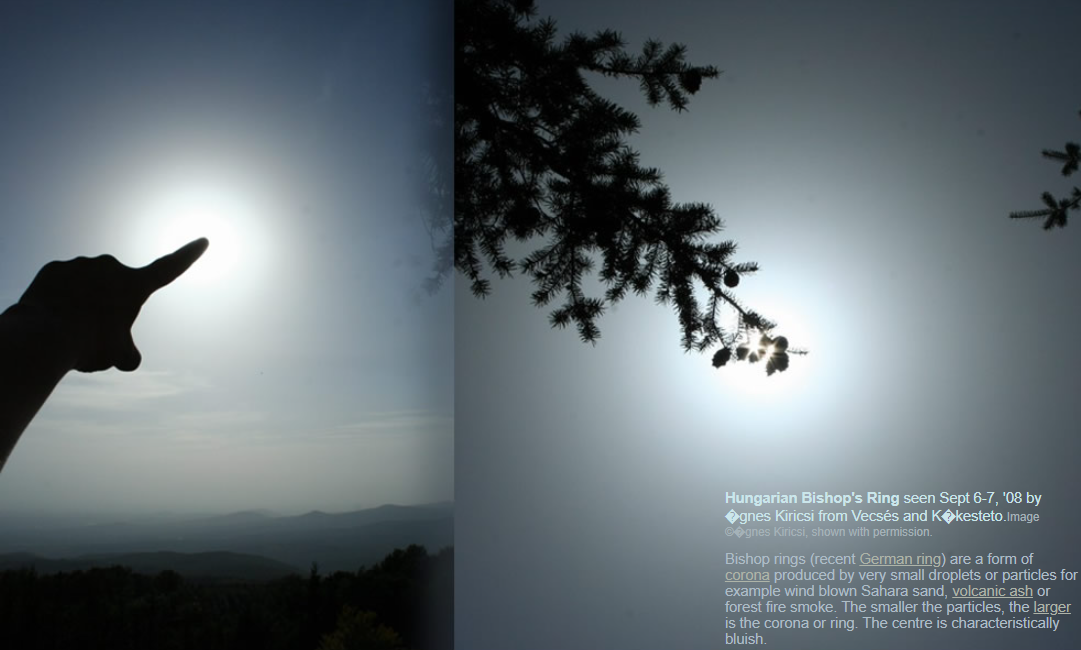Hungarian Bishop
Hungarian Bishop's Ring: A Stunning Atmospheric Phenomenon
The Hungarian Bishop's Ring is a captivating atmospheric optics phenomenon that can leave observers in awe of its beauty. Also known as a corona, this optical phenomenon is formed by the diffraction and interference of light as it passes through very small droplets or particles suspended in the air. These particles can be anything from wind-blown Sahara sand to volcanic ash or even smoke from forest fires. The size of the particles plays a crucial role in the appearance of the corona, with smaller particles resulting in larger and more vibrant rings.
When witnessing a Hungarian Bishop's Ring, one cannot help but be captivated by its striking visual display. The center of the ring is characterized by a distinct bluish hue, which adds to its ethereal charm. This unique feature distinguishes the Hungarian Bishop's Ring from other corona phenomena, making it an intriguing subject for atmospheric optics enthusiasts.
To fully appreciate the intricacies of the Hungarian Bishop's Ring, it is important to understand the science behind its formation. When sunlight or moonlight passes through the tiny droplets or particles in the atmosphere, it undergoes diffraction and interference. This bending and scattering of light waves result in the formation of concentric rings around the source of light. The specific size and arrangement of these droplets or particles determine the size and intensity of the corona.
The Hungarian Bishop's Ring is particularly fascinating due to its association with various types of airborne particles. While wind-blown Sahara sand, volcanic ash, and forest fire smoke are common culprits, other particulates can also contribute to the formation of this mesmerizing phenomenon. The presence of these particles in the atmosphere adds an element of unpredictability to the appearance of the Hungarian Bishop's Ring, making each sighting a unique experience.
Observing a Hungarian Bishop's Ring can be a rare occurrence, as it requires specific atmospheric conditions for its formation. The presence of small, uniformly sized particles is crucial, as larger particles do not produce the same intricate ring pattern. Additionally, the angle at which the light passes through these particles determines the size and shape of the corona. These factors, combined with the availability of a suitable light source such as the sun or moon, contribute to the sporadic nature of this optical phenomenon.
Photographers and sky enthusiasts alike have been captivated by the beauty of the Hungarian Bishop's Ring. Its delicate, shimmering rings create a magical spectacle against the backdrop of the sky. Capturing this phenomenon on camera can be challenging, as it requires precise timing and positioning to capture the full extent of its beauty. However, those fortunate enough to witness and photograph a Hungarian Bishop's Ring are rewarded with images that showcase the wonders of atmospheric optics.
In conclusion, the Hungarian Bishop's Ring is a captivating atmospheric phenomenon that never fails to mesmerize observers. Its unique characteristics, including the distinct bluish center and the association with various types of airborne particles, make it a subject of fascination for atmospheric optics enthusiasts. While its occurrence may be sporadic and dependent on specific atmospheric conditions, those lucky enough to witness and photograph a Hungarian Bishop's Ring are treated to a breathtaking display of nature's wonders. So, keep your eyes to the sky and be prepared to be amazed by this awe-inspiring optical phenomenon.

Hungarian Bishop's Ring seen Sept 6-7, '08 by �gnes Kiricsi from Vecsés and K�kesteto.Image ©�gnes Kiricsi, shown with permission.
Bishop rings (recent German ring) are a form of corona produced by very small droplets or particles for example wind blown Sahara sand, volcanic ash or forest fire smoke. The smaller the particles, the larger is the corona or ring. The centre is characteristically bluish.
Note: this article has been automatically converted from the old site and may not appear as intended. You can find the original article here.
Reference Atmospheric Optics
If you use any of the definitions, information, or data presented on Atmospheric Optics, please copy the link or reference below to properly credit us as the reference source. Thank you!
-
<a href="https://atoptics.co.uk/blog/hungarian-bishop/">Hungarian Bishop</a>
-
"Hungarian Bishop". Atmospheric Optics. Accessed on April 18, 2024. https://atoptics.co.uk/blog/hungarian-bishop/.
-
"Hungarian Bishop". Atmospheric Optics, https://atoptics.co.uk/blog/hungarian-bishop/. Accessed 18 April, 2024
-
Hungarian Bishop. Atmospheric Optics. Retrieved from https://atoptics.co.uk/blog/hungarian-bishop/.